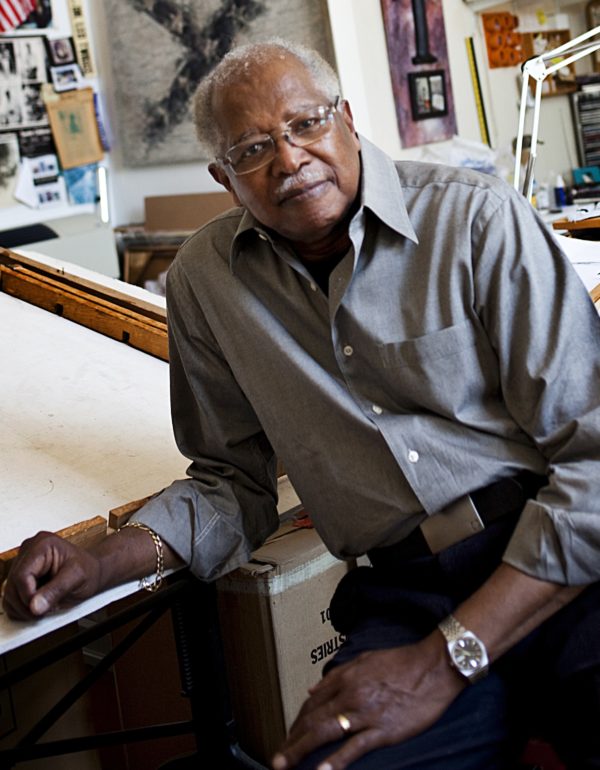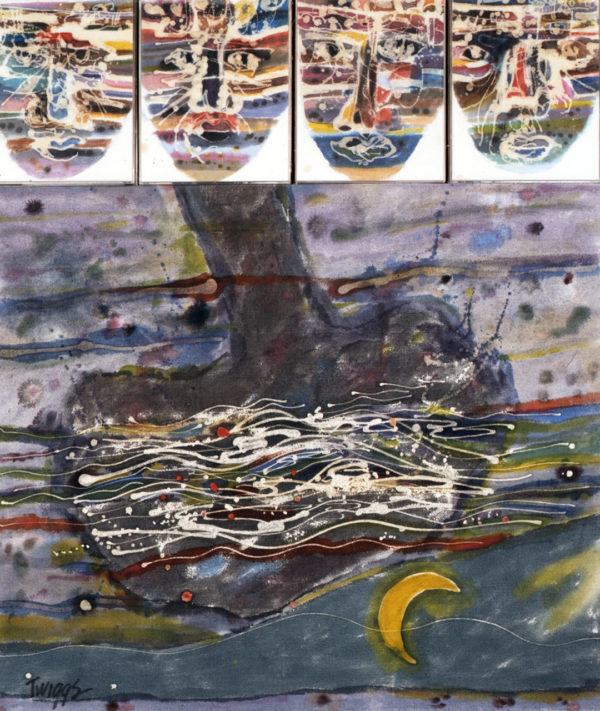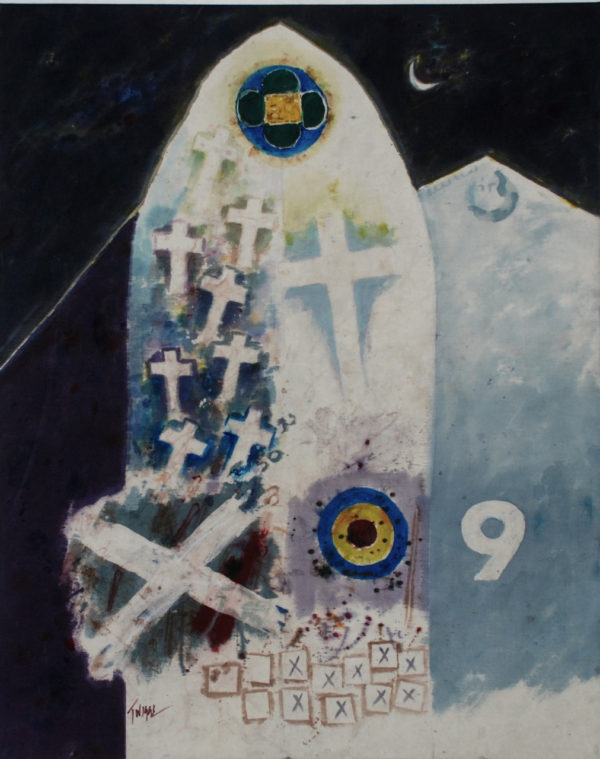When you walk into Leo Twiggs’s Orangeburg studio, you can’t help but smile. The welcoming vibe of the space is enhanced by Twiggs himself, who greets his visitors with a huge smile and open arms. He is full of energy and creative spirit, yet incredibly mellow—characteristics that carry over into his art. The walls of the light-filled studio are stacked high with artwork and objects of inspiration: African masks, old exhibition posters, dried gourds, and beautifully woven baskets. Tables and countertops are covered with jars of dye and paintbrushes, ready for the artist to spring into action. It is clear that something special happens here.

Twiggs works in batik, an ancient wax-resist method of dyeing textiles. He begins his batik works by sketching on fabric, generally cotton or silk. Twiggs then applies wax before dipping the cloth in a cold water dye solution. The areas covered in wax resist the dye, preserving the original color of the cloth. This process is repeated many times with different colors to produce a richly-layered effect. Removal of the wax with a hot iron reveals the final composition. The medium demands patience, encourages improvisation, and forces periods of contemplation.
But before the first drop of dye hits the cloth, Twiggs must conceive his subject matter. Like a child doodling in class, many of his ideas originate as sketches created during meetings, along the margins and on the reverse of meeting agendas, church bulletins, and the like. Twiggs stashes these sketches in a folder for easy reference when planning new paintings.
Much of Twiggs’ work melds the past with the present as he explores family history, cultural heritage, and how the past is manifest in contemporary life. Therefore, it is not surprising that Twiggs draws inspiration from both the historic and the contemporary. He is moved by old photographs and documents, but also the clean lines of modern furniture. He admires traditional homes infused with a contemporary flair and the design and packaging of Apple products. Twiggs continually looks to contemporary design in his everyday life as a source for artistic inspiration.

Like many artists, Twiggs also draws inspiration from nature and the built environment. Surface is an important aspect of his work. He observes the surfaces of buildings, sidewalks, and items from nature, such as the gourds that hang on his studio walls, and translates the subtle gradations of color and texture into his work. The batik medium lends well to such subtleties, and the spidery lines of dye soaked into the fabric give a timeworn effect. Twiggs enhances this effect through the use of earth tones that root his paintings in nature and the spirituality of the land.
While Twiggs creates sketches and plans his compositions, he tries not to control the process too much, and rather lets the creative process evolve naturally. According to Twiggs, he takes his paintings “where the spirit leads me.” He gives in to the creative process, follows the feeling, and embraces the unexpected. Twiggs likens his improvisation to that of a jazz musician. Just as the musician improvises as the spirit moves him, so too does Twiggs. This improvisation takes him to a new level of creativity that he cannot predetermine or plan. Twiggs acknowledges, “You cannot go there, you cannot arrive there.”
When Twiggs “arrives there,” one painting is often not enough. He tends to work in series in order to explore his ideas to the fullest. Twiggs follows his creative spirit for as long as necessary, sometimes spending years on a single series. Computers and digital imaging have revolutionized the way that Twiggs approaches his works, allowing him to view an entire series of paintings on his computer screen. This enables him to analyze the work as a whole and contemplate his next steps.
Recently, Twiggs completed a series of nine batik paintings entitled Requiem for Mother Emanuel. Two of the paintings are currently on view at the Gibbes (read more on our blog here). The series pays tribute to the nine parishioners murdered in a racially-motivated shooting at Mother Emanuel AME Church in Charleston on June 17, 2015. Twiggs’s paintings convey the pain and horror of the shooting but also the incredible spirit of grace and unity that filled the city of Charleston immediately following the tragedy. As Twiggs explains, he sought to capture “the one shining moment people came together not because of the color of their skin but because of the humanness in their heart.”

His Requiem for Mother Emanuel series was one of the reasons Twiggs was recently named winner of the 1858 Prize for Contemporary Southern Art. Awarded by Society 1858 of the Gibbes Museum of Art, the Prize honors an exceptional artist whose work contributes to a new understanding of the American South. Twiggs was selected for creating powerful work that is simultaneously personal and universal. He explains, “It is not just my story; it’s about humanity, the human experience.” Perhaps this approach is what gives his paintings a sense of spirituality. Twiggs cannot describe or explain this spirituality, but he knows when it is present in a painting. In a similar vein, visitors to Twiggs’ studio cannot quite put their finger on what makes the place so special, but it is special nonetheless. To spend time with Leo Twiggs is to be inspired by a wonderful, creative energy that leaves you smiling long after you wave goodbye.
— Pam Wall, Exhibitions Consultant
Published August 17, 2018
Top Image: Midnight Special, 2000, by Leo Twiggs; batik, 14 x 24 inches; courtesy of the artist
Leo Twiggs will accept the award and make remarks at the Amy P. Coy Forum and Prize Party on Wednesday, September 19, at 6pm. For tickets and more information, click here.

